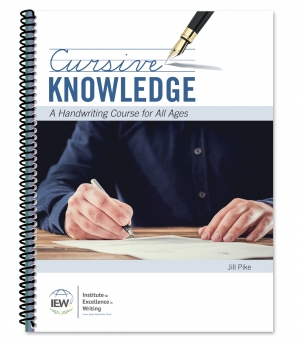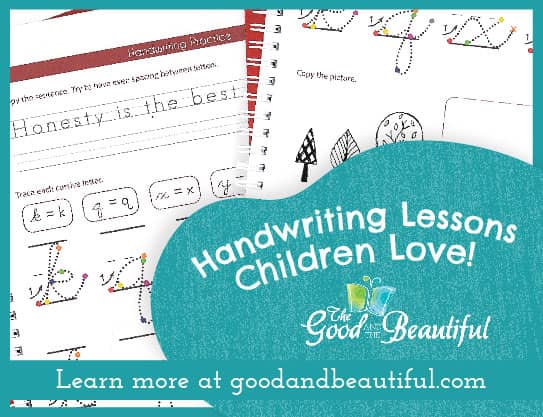Cursive Knowledge efficiently teaches cursive handwriting within a single book.
It teaches the formation of letters by grouping together letters that share the same beginning strokes. There are four groups for the lowercase letters and eight groups for the uppercase letters. The author, Jill Pike, gives each group a descriptive name as a practical way to teach the common elements for each group. For instance, “loop starters” are lowercase letters for which we start at the bottom and go up to form a loop─the letters l, e, k, b, h, and f.
Students learn to write lowercase letters first, then they practice joining letters into words. Uppercase letters are taught after this. Pike is careful to point out when students will need to add an extra stroke such as for crossing the lowercase t or the uppercase F.
Cursive Knowledge was designed for ages eight and above although you can use it with younger students if you work closely with them. Instructional information is written directly to the student, so older learners can work independently. Parents and teachers can easily direct younger students, allowing them to move at a slower rate or assigning additional practice outside the book if it is needed.
The lines in the book for completing written exercises have a dashed midline. The lines are all large enough for children in the early elementary grades.
Pike doesn’t emphasize slant, although all the models in the book show a traditional slant. In the introduction, she explains how right- or left-handed writers might position their paper for writing. However, as a left-handed writer herself, she recognizes their tendency to write with an awkward back slant and the problem they have with smearing. So she suggests ways for left-handed writers to overcome those problems.
Cursive Knowledge presents the course as 24 “tasks” plus an additional 19 pages at the end of the book for copywork practice. Pike says that students should complete each of the 24 tasks in fifteen minutes or less. If students work on these every school day, it should take a month for an older student to complete the basic lessons, but younger students will probably need more time.
The copywork pages that follow the 24 tasks each have a quotation at the top for students to write on the blank lines that fill the rest of each page. There should be space for students to copy most of these at least twice, and this might be done over the span of more than one day. The first four copywork pages have the same size lines as are provided throughout the first 24 tasks. Beginning with the fifth page of copywork, the lines are smaller, although they are still wider than those on regular lined paper, and they still have the dashed midline.
The last page in the book is printed on cardstock and shows the forms for all uppercase and lowercase letters. This should be removed from the book and kept handy for reference. It might be particularly useful when students start the copywork, since the quotations are typed rather than shown as cursive models.
You are probably aware that some publishers offer complete handwriting courses that are used over a number of years—quite a contrast to this course that can be completed in just a few months. Some students might need the additional practice offered by the multi-year programs. On the other hand, some parents and teachers are skipping cursive instruction entirely, relying on printing skills and the use of keyboards. It seems to me that Cursive Knowledge offers an efficient compromise solution so that you can provide cursive instruction and take only a little time away from the rest of your curriculum.







![Cursive Knowledge [Student Book]](https://g.christianbook.com/dg/product/cbd/b180/413004.gif)




